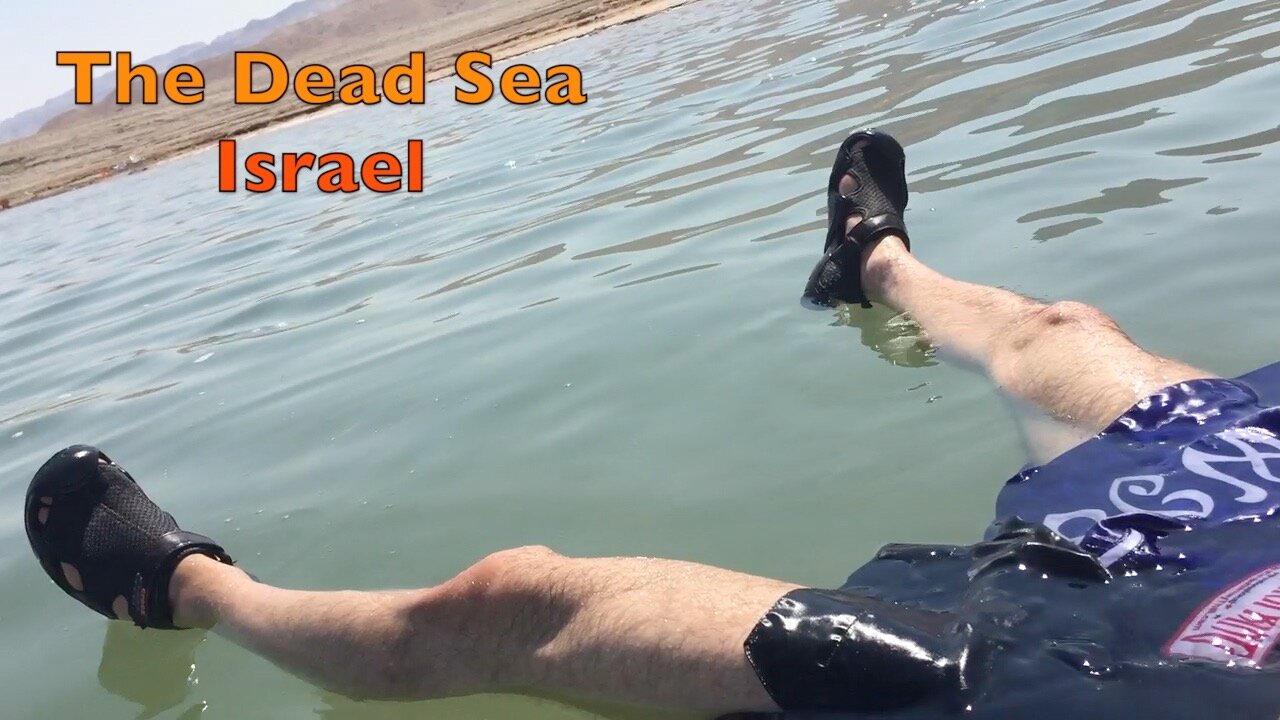Premium Only Content

Floating in the Dead Sea - You Can't Sink! - Interesting Facts
The Dead Sea (Hebrew: יָם הַמֶּלַח, Yam ha-Melah, "Sea of Salt", also Hebrew: יָם הַמָּוֶת, Yam ha-Mavet, "The Sea of Death", and Arabic: البحر الميت About this sound Al-Bahr al-Mayyit (help·info)), also called the Salt Sea, is a salt lake bordered by Jordan to the east and Israel and Palestine to the west. Its surface and shores are 429 metres (1,407 ft) below sea level, Earth's lowest elevation on land. The Dead Sea is 304 m (997 ft) deep, the deepest hypersaline lake in the world. With 34.2% salinity (in 2011), it is 9.6 times as salty as the ocean, and one of the world's saltiest bodies of water. This salinity makes for a harsh environment in which plants and animals cannot flourish, hence its name. The Dead Sea is 50 kilometers (31 mi) long and 15 kilometers (9 mi) wide at its widest point. It lies in the Jordan Rift Valley and its main tributary is the Jordan River.
The Dead Sea water has a density of 1.24 kg/liter, which makes swimming similar to floating.
Biblical period-
Dwelling in caves near the Dead Sea is recorded in the Hebrew Bible as having taken place before the Israelites came to Canaan, and extensively at the time of King David.
Just northwest of the Dead Sea is Jericho. Somewhere, perhaps on the southeastern shore, would be the cities mentioned in the Book of Genesis which were said to have been destroyed in the time of Abraham: Sodom and Gomorra (Genesis 18) and the three other "Cities of the Plain", Admah, Zeboim and Zoar (Deuteronomy 29:23). Zoar escaped destruction when Abraham's nephew Lot escaped to Zoar from Sodom (Genesis 19:21-22). Before the destruction, the Dead Sea was a valley full of natural tar pits, which was called the vale of Siddim. King David was said to have hidden from Saul at Ein Gedi nearby.
In Ezekiel 47:8-9 there is a specific prophecy that the sea will ".. be healed and made fresh", becoming a normal lake capable of supporting marine life. A similar prophecy is stated in Zechariah 14:8, which says that "Living waters will go out from Jerusalem, half of them to the eastern sea (likely the Dead Sea) and half to the western sea (the Mediterranean)..."
Greek and Roman period-
Aristotle wrote about the remarkable waters. The Nabateans and others discovered the value of the globs of natural asphalt that constantly floated to the surface where they could be harvested with nets. The Egyptians were steady customers, as they used asphalt in the embalming process that created mummies. The Ancient Romans knew the Dead Sea as "Palus Asphaltites" (Asphalt Lake).
King Herod the Great built or rebuilt several fortresses and palaces on the western bank of the Dead Sea. The most famous was Masada, where in 70 CE a small group of Jewish zealots fled after the fall of the destruction of the Second Temple. The zealots survived until 73 CE, when a siege by the X Legion ended in the deaths by suicide of its 960 inhabitants. Another historically important fortress was Machaerus (מכוור), on the eastern bank, where, according to Josephus, John the Baptist was imprisoned by Herod Antipas and died.
Also in Roman times, some Essenes settled on the Dead Sea's western shore; Pliny the Elder identifies their location with the words, "on the west side of the Dead Sea, away from the coast ... [above] the town of Engeda" (Natural History, Bk 5.73); and it is therefore a hugely popular but contested hypothesis today, that same Essenes are identical with the settlers at Qumran and that "the Dead Sea Scrolls" discovered during the 20th century in the nearby caves had been their own library.
Josephus identified the Dead Sea in geographic proximity to the ancient Biblical city of Sodom. However, he referred to the lake by its Greek name, Asphaltites.
Various sects of Jews settled in caves overlooking the Dead Sea. The best known of these are the Essenes of Qumran, who left an extensive library known as the Dead Sea Scrolls. The town of Ein Gedi, mentioned many times in the Mishna, produced persimmon for the temple's fragrance and for export, using a secret recipe. "Sodomite salt" was an essential mineral for the temple's holy incense, but was said to be dangerous for home use and could cause blindness. The Roman camps surrounding Masada were built by Jewish slaves receiving water from the towns around the lake. These towns had drinking water from the Ein Feshcha springs and other sweetwater springs in the vicinity.
Byzantine period-
Intimately connected with the Judean wilderness to its northwest and west, the Dead Sea was a place of escape and refuge. The remoteness of the region attracted Greek Orthodox monks since the Byzantine era. Their monasteries, such as Saint George in Wadi Kelt and Mar Saba in the Judean Desert, are places of pilgrimage.
Music: Lover's Cove by Dhruva Aliman
Amazon- https://amzn.to/2MbZ3TF
https://music.apple.com/us/artist/dhruva-aliman/363563637
https://dhruvaaliman.bandcamp.com/album/snooper
http://www.dhruvaaliman.com/
Spotify - https://open.spotify.com/artist/5XiFCr9iBKE6Cupltgnlet
#travel
#Israel
#nature
-
 19:19
19:19
This Bahamian Gyal
1 day agoThe View PRAISES Michelle Obama for DITCHING TRUMP inauguration, "when they go LOW, go even LOWER"
7.08K10 -
 14:25
14:25
Degenerate Jay
19 hours ago $1.59 earnedThe Flash Movie Failed Because People Hate The Character? Sure.
20.6K7 -
 28:30
28:30
CharLee Simons Presents Do Not Talk
5 days agoSam Anthony from YourNews.com (with host CharLee Simons)
17.1K1 -
 52:34
52:34
PMG
15 hours ago $1.13 earnedHannah Faulkner and Steve Friend | EXPOSE THE FBI CORRUPTION - KASH PATEL
11.9K6 -
 25:33
25:33
marcushouse
1 day ago $36.78 earnedStarship Exploded! What Went Wrong? Flight Test 7 Explained
175K60 -
 1:00:50
1:00:50
Squaring The Circle, A Randall Carlson Podcast
1 day ago#035 Cosmic Catastrophe In The Age Of Leo - Squaring The Circle: A Randall Carlson Podcast
110K30 -
 1:33:14
1:33:14
Jamie Kennedy
1 day agoThe LA Fires...
89.6K20 -
 2:01:45
2:01:45
Quite Frankly
2 days ago"Inauguration Eve: Trump Time Travel Review" 1/17/25
68.1K64 -
 58:42
58:42
SGT Report
4 months agoYour REAL NEWS vs. CIA Mockingbird LIES -- Sam Anthony
195K97 -
 2:59
2:59
LimitlessAmbition
1 day ago $14.88 earnedPROVE THEM WRONG With This POWERFUL Motivation!
156K6